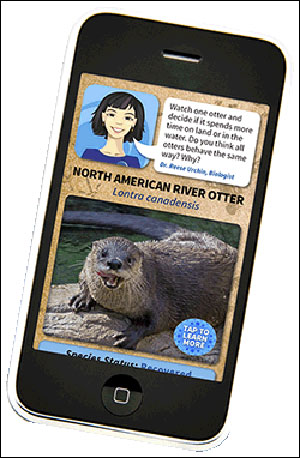The Tennessee Aquarium, in Chattanooga, is employing Bluetooth Low Energy (BLE) beacon technology to allow young visitors to play the role of scientist, by sending them alerts via the aquarium app on their smartphones. When a phone comes within range of the beacon mounted at nearly two dozen of its exhibits, the app receives a card asking the child to take note of a certain animal and its behaviors. The system was taken live two weeks ago.
The Tennessee Aquarium is a non-profit organization with a limited budget, says Thom Benson, the aquarium’s senior marketing and communications manager. So management counted it especially fortunate when Tennessee Technological University’s BusinessMedia Center donated its services last year to develop an app for the aquarium, and when, at the end of 2014, Chattanooga technology startup CloudBeacon provided beacons and related content-management software and services.
The result is the High-Tech Animal Tracker Program, which the aquarium released last week.
The aquarium app, available for download at both Google Play and iTunes, provides visitors with information before, during and after their visit, such as where to park, hours of service, scheduled daily events and details regarding the animals living at the facility.
With beacon technology, Benson says, the aquarium wanted to add role-playing to the app that would allow children—or even adults—to act as citizen scientists. (Citizen science is a form of research conducted by amateur or nonprofessional scientists.)
Thaddeus Taylor, a Tennessee Aquarium learning specialist, says that from the onset, the aquarium sought to engage its visitors, rather than simply interrupt them with unnecessary content as they moved through the exhibits. “We didn’t want this to just be a fact dump,” he says, noting that many people do not read printed panels on exhibit walls, rather prefer to simply look at the animals themselves. “We wanted to create a more game-like interaction.”
For the beacon functionality in the app, the aquarium created five wildlife biologist characters. After a user downloads the app, when he or she arrives at the aquarium, that person’s phone will receive transmissions from beacons in the vicinity (provided that its Bluetooth and notifications functionality are turned on), and the phone will then access content specific to the animals exhibited at that beacon location. Participants receive information about specific animals from a team of five avatar biologists, each specializing in a different animal group—fish, birds, insects, reptiles and amphibians.
In total, Taylor says, the aquarium has approximately 20 beacons installed at a variety of displays throughout its two buildings and IMAX 3D theater. The aquarium created a list of animals that met criteria for being endangered, threatened or recovered, he explains, and beacons were installed at those animals’ exhibits.
Users can then begin seeking out animals, including a gopher tortoise, a sand tiger shark, a Denison barb or a tawny owl butterfly. Once the content is displayed for a user, he or she can read more about that animal, as well as practice some basic research, such as counting the number of a specific type of fish within a certain area of a tank, in order to track their behavior. The system is solely intended for entertainment, Benson says, though in the future, the aquarium could opt to configure the app to both send and receive content to users, so that, for instance, children could forward their observations to the app’s server.
CloudBeacon—a company launched by research and development startup studio LPG Lab, a division of Lamp Post Group (LPG)—found the aquarium to be a good test bed for its content-management system (CMS). CloudBeacon offers its own app, known as Warble, as well as a service that integrates its CMS into an existing app, as it did for the aquarium. Such integration, says Justin Junda, a CloudBeacon co-founder and developer, poses more challenges than simply providing an app, since the beacon-based solution needed to work seamlessly with existing app content, while also enabling content managers—in this case, the aquarium—to change, add or delete content related to the beacons, as necessary. The aquarium will create the content and then use CloudBeacon’s CMS to change the theme of the beacon experience, in accordance with seasonal promotions.
The beacon deployment itself posed some challenges, due to the facility’s numerous nooks and crannies, its tanks full of water and some areas of high humidity, such as the butterfly area. CloudBeacon deployed a variety of off-the-shelf beacons, as well as some custom-made for CloudBeacon by a third party. The company individually set each beacon’s read range according to the environment in which it was being installed.
However, says Jason Provonsha, another of CloudBeacon’s three co-founders and its sales director, the solution is designed to be easy to set up and operate. In the future, he adds, the aquarium or other users could install the beacons themselves, and then simply access CloudBeacon’s CMS and update content for a particular beacon.
CloudBeacon’s solution, the founders claim, is unique for its focus on an easy-to-use content-management system that offers an alternative to a software developer’s kit (SDK). Most users, they note, will not want to hire someone to program solutions via an SDK.
Since the solution was taken live, Taylor reports, the aquarium is “still ironing out the details,” including whether to have visitors’ smartphones use a vibration or audio cue to provide an alert when participants come within range of an animal. The goal, he explains, is to encourage visitor involvement, and to foster discussions among participants (family members, for instance) regarding threatened or endangered animals. “We’ll be keeping tabs on the app download rate,” he says. The company performed some benchmark app download rate measuring prior to adding the beacon system, so that it could compare the results with the download rates now that the High-Tech Animal Tracker Program is up and running.


